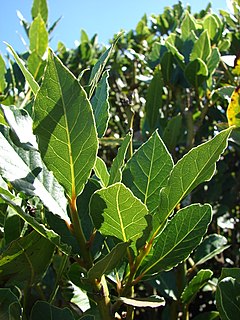
The bay leaf is an aromatic leaf commonly used in cooking. It can be used whole or in a dried or ground form.
Athleta Christi was a class of Early Christian soldier martyrs, of whom the most familiar example is one such "military saint," Saint Sebastian.

Laurus nobilis is an aromatic evergreen tree or large shrub with green, glabrous smooth leaves, in the flowering plant family Lauraceae. It is native to the Mediterranean region and is used as bay leaf for seasoning in cooking. Its common names include bay tree, bay laurel, sweet bay, true laurel, Grecian laurel, or simply laurel. Laurus nobilis figures prominently in classical Greco-Roman culture.

Nobilis is a contemporary fantasy tabletop role-playing game created by Jenna K. Moran, writing under the name R. Sean Borgstrom. The player characters are "Sovereign Powers" called the Nobilis; each Noble is the personification of an abstract concept or class of things such as Time, Death, cars, or communication. Unlike most role-playing games, Nobilis does not use dice or other random elements to determine the outcome of characters' actions, but instead uses a point-based system for task resolution.

Roberto de Nobili was an Italian Jesuit missionary to Southern India. He used a novel method of adaptation (accommodatio) to preach Christianity, adopting many local customs of India which were, in his view, not contrary to Christianity.
John Nobili, born Giovanni Pietro Antonio Nobili, (S.J.) was an Italian priest of the Society of Jesus. He was a missionary in the Oregon Territory and later founded Santa Clara College in California, United States.

The red-shouldered macaw is a small green South American parrot, a member of a large group of Neotropical parrots called macaws. The species is named for the red coverts on its wings. It is the smallest macaw, being 30–35 cm (12–14 in) in length - similar in size to the Aratinga parakeets. It is native to the tropical lowlands, savannah, and swamplands of Venezuela, the Guianas, Bolivia, Brazil, and far south-eastern Peru. It has two distinct subspecies, the noble macaw and the Hahn's macaw, and a possible poorly distinct third subspecies that has longer wings, but is otherwise similar to the noble macaw. The Hahn's subspecies is named for German zoologist Carl-Wilhelm Hahn, who in 1834 began compiling Ornithologischer Atlas oder naturgetreue Abbildung und Beschreibung der aussereuropäischen Vögel.

Steatoda nobilis is a spider in the genus Steatoda, known in the United Kingdom as the noble false widow and is often referred to as the false widow. As the common name indicates, the spider superficially resembles and is frequently confused for the black widow and other spiders in the genus Latrodectus. S. nobilis has medically significant venom, where in England, it has a reputation as one of the few local spider species that is capable of inflicting a painful bite to humans, with most bites resulting in symptoms similar to a bee or wasp sting.

Costa de' Nobili is a comune (municipality) in the Province of Pavia in the Italian region Lombardy, located about 40 km southeast of Milan and about 20 km southeast of Pavia.

Banksia nobilis, commonly known as the golden dryandra, great dryandra or kerosene bush, is a shrub of the family Proteaceae which is endemic to Western Australia. It occurs on lateritic rises from Eneabba to Katanning in the state's Southwest Botanic Province. With large pinnatifid leaves with triangular lobes, and a golden or reddish pink inflorescence, it is a popular garden plant. It was known as Dryandra nobilis until 2007, when all Dryandra species were transferred to Banksia by Austin Mast and Kevin Thiele. There are two subspecies, B. nobilis subsp. nobilis and B. nobilis subsp. fragrans.

Alex George's taxonomic arrangement of Dryandra was the first modern-day arrangement of that taxon. First published in Nuytsia in 1996, it superseded the arrangement of George Bentham, which had stood for over a hundred years; it would later form the basis for George's 1999 treatment of Dryandra for the Flora of Australia. In accordance with contemporary thinking, George treated Dryandra as a genus, dividing it into three subgenera, the largest of which was divided into 24 series. The arrangement stood until 2007, when Dryandra was transferred into Banksia as B. ser. Dryandra. No alternative has yet been proposed.
The Gran Premio Nobili Rubinetterie is a single-day road bicycle race held annually in Arona, Italy. Since 2005, the race has been organised as a 1.1 event on the UCI Europe Tour. In 2010 the GP was split in two challenges, Coppa Papà Carlo and Coppa Città di Stresa, but reverted to a single race – on the route of the Coppa Città di Stresa – in 2012.
Banksia nobilis subsp. nobilis is a subspecies of Banksia nobilis. As an autonym, it is defined as encompassing the type material of the species. It was known as Dryandra nobilis subsp. nobilis until 2007, when Austin Mast and Kevin Thiele transferred Dryandra into Banksia. As with other members of Banksia ser. Dryandra, it is endemic to the South West Botanical Province of Western Australia.

Dryandra subg. Dryandra is an obsolete clade of plant. It was a series within the former genus Dryandra. The name was first published at sectional rank as Dryandra verae in 1830, before being renamed Eudryandra in 1847, the replaced by the autonym at subgenus rank in 1996. It was ultimately discarded in 2007 when Austin Mast and Kevin Thiele sunk Dryandra into Banksia.
Iphiseiodes is a genus of mites in the Phytoseiidae family.
Iphiseiodes metapodalis is a species of mite in the family Phytoseiidae.
Iphiseiodes neonobilis is a species of mite in the family Phytoseiidae.
Iphiseiodes quadripilis is a species of mite in the family Phytoseiidae.
Iphiseiodes setillus is a species of mite in the family Phytoseiidae.

De Nobili School, CMRI, associated with the former Central Mining Research Institute in Dhanbad, Jharkhand, India, has classes one through twelve and is run by the Society of Jesus.










